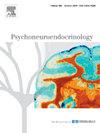Stress responses of infants and mothers to a still-face paradigm after traumatic childbirth
IF 3.4
2区 医学
Q2 ENDOCRINOLOGY & METABOLISM
引用次数: 0
Abstract
Introduction
One-third of women experience childbirth as traumatic and some develop symptoms of childbirth-related posttraumatic stress symptoms (CB-PTSD symptoms). Whether CB-PTSD symptoms negatively impact on physiological and psychological stress responses in mothers and their offspring and whether they are associated with mother-infant synchrony is not clear. This study aimed to investigate stress responses of (1) mothers with CB-PTSS, (2) of their infant, and (3) the physiological mother-child-synchrony at six months postpartum.
Method
Psychophysiological (cortisol and vagal tone) and psychological stress responses of mothers and infant’s (n=31 dyads) from the Swiss TrAumatic biRth Trial (NCT03576586) were assessed during a face-to-face still-face paradigm (FFSF-R).
Results
There was a significant time effect in maternal stress responses for salivary cortisol, vagal tone, and for maternal subjective stress. As expected, mothers’ subjective stress increased during the stress task and mothers vagal tone changed during the first stressful period but not during the second, whereas cortisol unexpectedly decreased over the FFSF-R. Infant negative mood increased over the experiment, but there were no physiological changes. However, a significant interaction effect for mother-infant synchrony during the second reunion period of the FFSF-R was found.
Conclusion
Although mothers and their infants were subjectively stressed, they showed only limited physiological stress responses.
创伤性分娩后婴儿和母亲对静止面部范例的应激反应。
导言:三分之一的妇女在分娩时会受到创伤,有些妇女会出现与分娩相关的创伤后应激症状(CB-PTSD 症状)。CB-创伤后应激障碍症状是否会对母亲及其后代的生理和心理应激反应产生负面影响,以及这些症状是否与母婴同步相关,目前尚不清楚。本研究旨在调查(1)CB-PTSD 母亲的应激反应;(2)婴儿的应激反应;以及(3)产后 6 个月母婴生理同步性:方法:在面对面静止范式(FFSF-R)中评估瑞士TrAumatic biRth试验(NCT03576586)中母亲和婴儿(31对)的心理生理(皮质醇和迷走神经张力)和心理应激反应:在唾液皮质醇、迷走神经张力和母亲主观压力方面,母亲的压力反应存在明显的时间效应。正如预期的那样,母亲的主观压力在压力任务期间增加了,母亲的迷走神经张力在第一个压力期发生了变化,但在第二个压力期没有变化,而皮质醇在 FFSF-R 期间出乎意料地减少了。婴儿的负面情绪在实验过程中有所增加,但生理上没有变化。然而,在FFSF-R的第二个重聚期,发现母婴同步性有明显的交互效应:结论:虽然母亲和婴儿主观上感到压力,但他们仅表现出有限的生理压力反应。
本文章由计算机程序翻译,如有差异,请以英文原文为准。
求助全文
约1分钟内获得全文
求助全文
来源期刊

Psychoneuroendocrinology
医学-精神病学
CiteScore
7.40
自引率
8.10%
发文量
268
审稿时长
66 days
期刊介绍:
Psychoneuroendocrinology publishes papers dealing with the interrelated disciplines of psychology, neurobiology, endocrinology, immunology, neurology, and psychiatry, with an emphasis on multidisciplinary studies aiming at integrating these disciplines in terms of either basic research or clinical implications. One of the main goals is to understand how a variety of psychobiological factors interact in the expression of the stress response as it relates to the development and/or maintenance of neuropsychiatric illnesses.
 求助内容:
求助内容: 应助结果提醒方式:
应助结果提醒方式:


